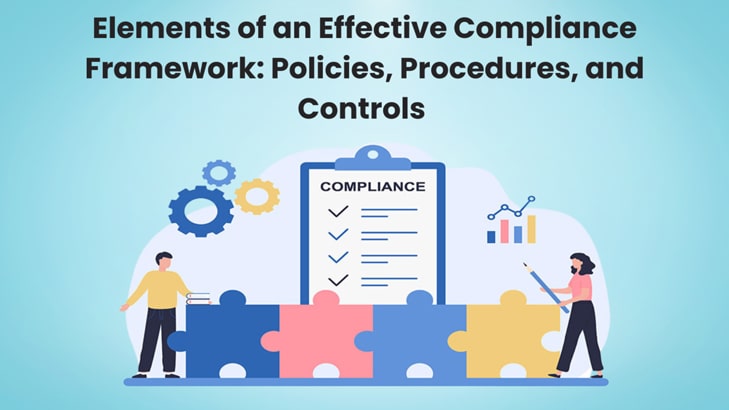Building a solid compliance framework is essential for managing the regulatory landscape in corporate operations. This framework is the cornerstone upon which organisations establish responsibility, foster trust, and protect themselves from legal ramifications. Achieving and keeping a Compliance Certification has come to be associated with good corporate governance in today’s business environment.
In this blog, we will focus on the three essential elements of a successful Compliance Framework: Policies, Procedures, and Controls.
Understanding the Compliance Framework
Like a well-oiled engine, a well-structured framework integrates different parts flawlessly to guarantee that an organisation operates within ethical and legal bounds. The phrase “compliance framework” refers to a systematic process that includes developing policies, outlining procedures, and implementing controls. An organisation’s dedication to following industry rules, standards, and best practices is based on this triangle.
Policies as the Guiding Principles
The foundation of every successful framework is its policies, which serve as the guiding principles that establish the standards for moral behaviour inside an organisation. These live rules represent the company’s fundamental principles and standards, not just paperwork on dusty shelves. Policies define the parameters and expectations that control employee behaviour, whether related to data protection, anti-discrimination, or financial transparency. Obtaining compliance certification often starts with carefully reviewing and recording these rules to ensure they are in complete harmony with the organisation’s primary goals.
Procedures for Translating Policies into Action
Procedures are the second essential component of compliance once policies are in place. Consider policies as a road map and procedures as a clear means for staff members to convert policy directives into concrete measures. Procedures define the mechanisms necessary to implement policies practically, acting as the foundation for action. For example, a data protection policy may stress how important it is to safeguard sensitive data, and the related process would explain what workers need to do to encrypt and store data safely.
Controls for Safeguarding Compliance
The last member of our trio is controls, which is how an organisation ensures that its rules and procedures are followed. As the checks and balances, controls keep an eye on and evaluate whether the rules and guidelines successfully prevent infractions of the law. Internal audits, routine risk assessments, and technology solutions intended to reduce possible hazards are all examples of this. The efficacy of these controls is often a determining factor in obtaining and retaining compliance certification, indicating a dedication to ongoing process improvement in compliance.
The Synergy of Policies, Procedures, and Controls
Establishing a framework that passes regulatory scrutiny requires a thorough understanding of the interplay between rules, processes, and controls. Procedures convert these ideals into workable processes, controls guarantee the continuous efficacy of the framework, and policies provide the ethical framework. The interaction of these components improves an organisation’s internal operations and establishes it as a reliable and accountable member of the larger business community.
The Role of Compliance Certification
Getting a compliance certification is more than just a badge of honour in an age when corporate accountability is scrutinised increasingly—it is a strategic need. This accreditation attests to an organisation’s dedication to moral business conduct and acts as an external validation. It assures all parties involved—from clients to investors—that the business stays within the law and other regulations. Compliance certification is the physical proof that an organisation’s compliance framework is a natural, breathing system that actively encourages ethical behaviour rather than only a paper trail.
Challenges in Crafting an Effective Compliance Framework
Developing a successful framework is a challenging task. The dynamic nature of regulations and the rapid progress of technology necessitates that organisations maintain flexibility in their compliance strategies. It is a constant struggle to balance effective operating efficiency and robust controls, necessitating early detection and risk mitigation. Moreover, the worldwide scope of commercial activities demands a sophisticated comprehension of several legal obligations, contributing additional intricacy to compliance endeavours.
The Future of Compliance
The direction of compliance frameworks is changing as we look to the future: they are becoming more proactive. A more anticipatory approach replaces the conventional reactive paradigm, in which organisations react to regulatory changes as they happen. By using cutting-edge technology like data analytics and artificial intelligence, organisations may anticipate possible compliance problems and take proactive steps to mitigate them. This proactive strategy positions organisations as leaders in moral and responsible business practices while strengthening the framework’s resilience.
Conclusion
To sum up, the constituents of a successful framework – rules, procedures, and controls – are not discrete items but rather integrated aspects of an all-encompassing approach. Creating a culture of compliance entails more than just following regulations; it also entails integrating moral behaviour into an organisation’s core values. Obtaining compliance certification, such as ISO & Compliance Courses, is evidence of an organisation’s dedication to surpassing regulatory requirements rather than merely meeting them. Frameworks must change with organisations but must also be flexible, robust, and compliant with good corporate governance practices.
